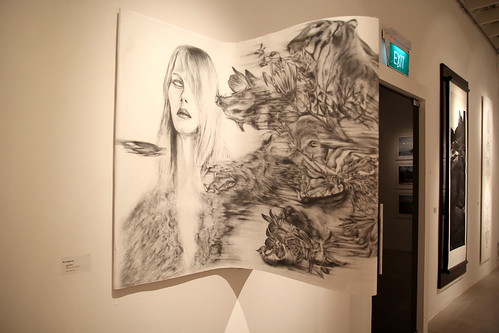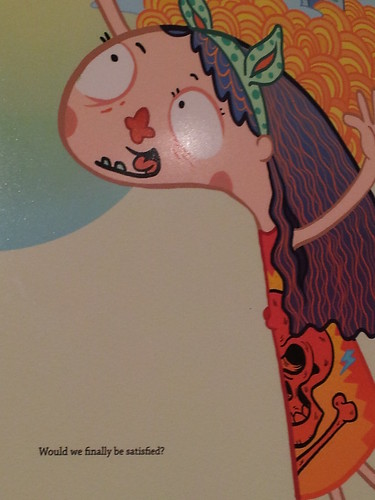We often talk about how the world has changed and how things today are different from the past but it is not often that we have a conversation about what if the world could change. What would we like to see different? Would the changes make it a better or worse world? Would we be able to cope?
The artists participating in The Apprenticeship Program (TAP) 2013 tackle this multifaceted question through their art as part of the Noise Singapore 2013 Festival. The exhibition opened last Friday (July 26, 2013) with the unveiling of artworks by 70 young artists at the Singapore Art Museum (SAM) at 8Q and will run until September 1, 2013.
TAP is unique in that it provides a learning ground for both artists and curators. The young artists picked for the program have been mentored by 23 established practitioners of art and design, photography and illustration and the show has been curated by three young curators who in turn were mentored by an experienced museum curator.
The theme which mirrors that of the Singapore Biennale 2013 is an opportunity for the young and talented artists to give their take on “If the World Changed” and provides many interesting insights. While some works reflect on how we negotiate change and the process of change, others explore what the future will hold as a result of this continuous change. Environment, politics, and Singapore’s ever changing urban landscape are popular themes explored. The works have been organized into three categories which according to the curators represent the different stages that one goes through when negotiating change. The categories are Introspection, Altered States of Reality and Empowerment.

10 Cents Entertainment by Ben Yap, Ian Tan and Lim Cheng Jun. Photograph: IT.
The work that greets you at the entrance of the exhibition space is a throwback to the past. 10 Cents Entertainment by Ben Yap, Ian Tan and Lim Cheng Jun uses the form of a cinema on wheels from the days of old to create windows of layered images that the audience can look into. Each window contains juxtaposed images of important events from the past but the narrative that each viewer experiences is based on his own interpretation of history through his own unique lens of experience and memory. With this work and before entering the exhibition space, the artists invite us to answer the question of whether the world has indeed changed or not.

Juncture by Tristan Lim. Photograph: JL.
Inside the exhibition space, the work that catches my eye first is Tristan Lim’s Juncture. The illustration is unique as it depicts two polarized ways of negotiating change in one’s environment. Acceptance and rejection of a change in our external reality is illustrated on the opposite sides of a protruding form so that only one perspective is visible at a time. The form of the work compels the audience to move around to the other side and to see what happens at the juncture where both the perspectives collide. Lim says the work illustrates how acceptance of change brings closure but in the process leaves one a shadow of their former self. The reverse or rejection of change causes internal conflict and affects the sanity of the person in the process. Lim makes use of animals to depict emotions- wild feral animals on one side and docile ones on the other portray the feelings of the individual negotiating change.

Welcome to Sardinapore by Calvin Ng. Photograph: IT.
Calvin Ng’s Welcome to Sardinapore, is a tongue-in-cheek warning of what a fictional country will become if its socio- political environment persists. Replacing people with sardines who are packed tightly into the country’s limited space, the work is a series of print collaterals that give us a glimpse of what life may be like in the country from the year 2040. An environment of active monitoring and self censorship will exist and the citizens will have been programmed to obey and believe what the government wants them to.
But not all is dark and gloomy in the exhibition. Elaine Chanchan’s If the World Changed (A Series of Thought Provoking Questions) explores the artist’s journey of first questioning what would happen if the world changed and then deciding to let go of the anxiety and just have fun with whatever comes. Her playful illustrations are whimsical and colourful and provide a sharp contrast to some of the other works in the exhibition.

A close-up of If the World Changed (A Series of Thought Provoking Questions) by Elaine Chanchan. Photograph: IT.
While TAP may seem like yet another in the line of exhibitions being held lately at SAM to showcase the younger artists, it is a show with a difference. Not only does it stand out from the past exhibitions in terms of the diversity of the medium chosen by the young artists but also in terms of the conceptual thought process that seems to have gone into creating the works. The partnership of the artists and curators with established practitioners in the field seemed to have paid off and was also visible in the enthusiasm of the apprentices at the opening. Photograph: IT.
Photographs: by Jessica Lim except where indicated
View our Official Opening of Noise Singapore 2013: The Apprenticeship Programme (TAP) Exhibition album.

Durriya Dohadwala
is an independent writer on contemporary Asian art and culture. She is also a docent and enjoys facilitating the decoding of contemporary Asian art.